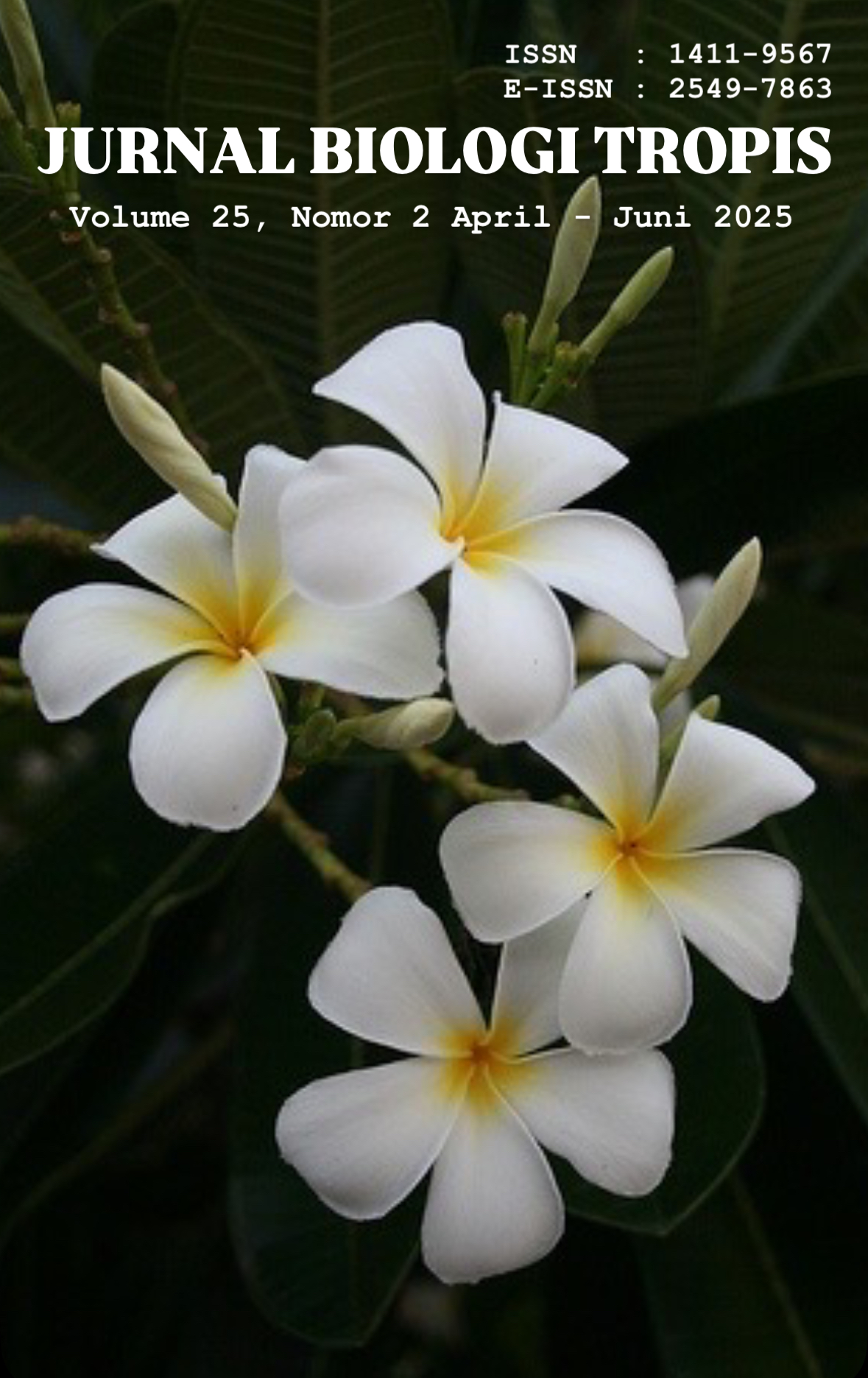
Most read articles by the same author(s)
- Ema Savitri, Anggit Prima Nugraha, Desi Natalia Hombing, Siti Atika, Wildani Firdaus, Species Diversity of Shrimp Caught by Fishermen in the Buffer Zone of East Cost Mangrove Forest Nature Reserve, Jambi Province , Jurnal Biologi Tropis: Vol. 25 No. 3 (2025): Juli-September
- Ipana Rosalia, Anggit Prima Nugraha, Dewi Aswin Setiyaningrum, Lulu’ Uljannah, Identification of Family Members Gobiidae in the Mangrove Forest Nature Reserve on the East Coast of Jambi Province , Jurnal Biologi Tropis: Vol. 25 No. 3 (2025): Juli-September
Similar Articles
- M. Abjan Fabanjo, Inayah Inayah, Analysis of Water Quality in the Mandaong River for Development of Freshwater Fish Cultivation , Jurnal Biologi Tropis: Vol. 21 No. 3 (2021): September - Desember
- Zaenafi Ariani, Muhammad Nursan, STRATEGI PENGEMBANGAN DESA MANTAR SEBAGAI KAWASAN DESA WISATA DI KABUPATEN SUMBAWA BARAT , Jurnal Biologi Tropis: Jurnal Biologi Tropis vol.17 No.2 Desember 2017
- Novi Ani, Kurniasih Sukenti, Evy Aryanti, Immy Suci Rohyani, Ethnobotany Study of Medicinal Plants by the Mbojo Tribe Community in Ndano Village at the Madapangga Nature Park, Bima, West Nusa Tenggara , Jurnal Biologi Tropis: Vol. 21 No. 2 (2021): Mei - Agustus
- Farah Diba, Muhammad Sholihin, Nurhaida Nurhaida, Utilization of plants as food source from Sebaju village forest, Nanga Kebebu village, Nanga Pinoh District, Melawi Regency , Jurnal Biologi Tropis: Vol. 21 No. 1 (2021): Januari - April
- Renianda, Rafdinal, Siti Ifadatin, Ethnobotany of Food Plants in The Malay Community in Ratu Sepudak Village, Galing District, Sambas Regency , Jurnal Biologi Tropis: Vol. 23 No. 2 (2023): Special Issue
- Reza Wariani, Muhlis Muhlis, I Gde Mertha, Ethnobotany of Traditional Medicine of The Sasak Bayan Tribe, Anyar Village, North Lombok , Jurnal Biologi Tropis: Vol. 23 No. 2 (2023): April-June
- Ani Suderajat, Riyanto Riyanto, Mulawarman Mulawarman, The Types of Trigona Bee (Apidae: Meliponinae) in Three Different Habitat in South Sumatra , Jurnal Biologi Tropis: Vol. 21 No. 1 (2021): Januari - April
- Nur Aini Bunyani, Maya Roman, Jorita Naisanu, Utilization of Forest Plants as Local Food Sources for the Oben Village Community, Nekamese District, Kupang Regency , Jurnal Biologi Tropis: Vol. 20 No. 3 (2020): September - Desember
- Asmita Asmita, Riza Linda, Dwi Gusmalawati, Ethnobotany of Medicinal Plants from the Malay People in Tanjung Village, Bunguran District, Northeastern District of Natuna Regency , Jurnal Biologi Tropis: Vol. 23 No. 2 (2023): April-June
- Fathul Yusro, Resky Pranaka, Indah Budiastutik, Yeni Mariani, Diversity of Medicinal Plants Used by Traditional Healers of Dayak Desa Tribe in the Villages of Kebong and Merpak, Sintang Regency , Jurnal Biologi Tropis: Vol. 20 No. 3 (2020): September - Desember
You may also start an advanced similarity search for this article.



























